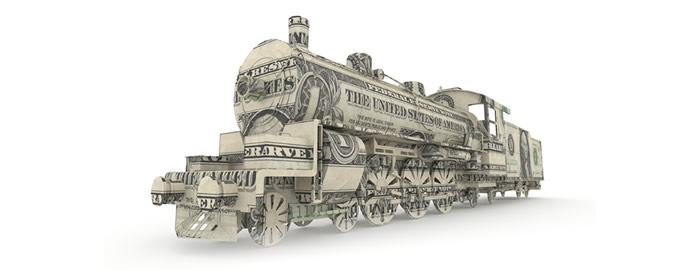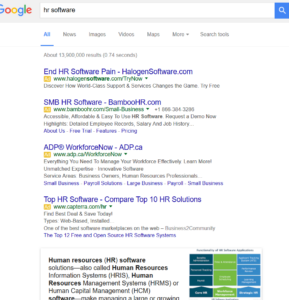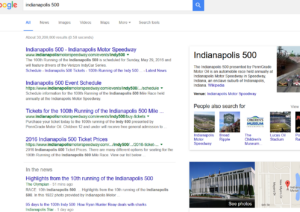Everyone’s talking about Google’s recent decision to remove AdWords ads from the right rail.
Let me humbly add the most incredibly cogent response to date.
A few folks noticed Google’s tests prior to the rollout. Some folks, like Moz’s Dr. Pete Myers, noticed a lot more than others.
Are some observers overreacting?
Probably.
Some of those in the bleachers tend to enjoy spectating primarily in terms of the superficial look and feel of the SERP. Since the playing field is so dynamic, I’m more compelled by arguments that look at the back-end data. Google already has much of that data (from testing the change), and in a few weeks, we’ll have it too. That’s when we should feel more comfortable commenting on what has changed.
It’s fair to be suspicious, though. It seems like the most important changes to the AdWords ecosystem are the ones that aren’t shared on the Inside AdWords blog. “Treating the community as an afterthought” probably wasn’t the vibe Google wanted to send. We’ve become accustomed to that “slick PR” feeling from Google. “Slick,” in this case, inevitably gave way to a need to fill the obvious information void — and that came through a series of murky email exchanges with certain online publications.
What explains the change, though?
In typical Google fashion, this change is a continuation of something that’s been emerging (not just through explicit tests, but through the general logic of user and advertiser practices and Google’s UX and profit motives) for several years. Kevin Ryan captured some of that basic logic, equating the right rail to a shabby, neglected building that was overdue to be torn down. Why weep?
With limited real-world data to go on, I’d like to remind people of a number of auction and SERP foibles that have been largely neglected in the conversations so far.
1. Ad positions worse than 5 have been irrelevant for nearly a decade; plus, Google has schemed and plotted for the last five years to make them even more irrelevant. And ad position 4 had no magical properties.
Some of the stunned reactions to the change seem to stem from a misguided belief that the main way Google relegates low-quality and low-bidding advertisers to the wilderness is through less visible ad positions. That may have been true in 2006, back when the only impact of a lower bid or a lower keyword Quality Score was on a keyword’s AdRank, which literally (only) controlled ad position. Back then, a lot of people liked to play around and marvel at what tactics got them into 4th, 7th, or even 11th ad position. (And, like any good SEO who can tell a client “hey, we’re in 10th spot, not the greatest, but at least you’re on Page 1!,” some bleacher observers have an irrational fear of a world that simply doesn’t offer a “10th spot.”) But since Google ushered in the Modern Era of Quality Score (roughly in August of 2008), Quality Score and keyword bid impact not only where you rank on the page, but your “eligibility in the auction,” or impression share against the queries for which your keyword might trigger ads. Dropping below a certain threshold doesn’t necessarily show up in reports as a low ad position, but it does reduce your eligibility to appear at all against any given search query. This underscores how seamless this change is going to be. Instead of sometimes showing up in 6th spot for some of your lower-quality, low-bid keywords, you will now not show up at all for them much of the time. (In other words: “What’s the difference?”) Given the marginal nature of that inventory as it stood, the overall impact on your campaigns will be minimal, unless you’re playing an exaggerated version of click arbitrage at very low bids. Meanwhile, the addition of a fourth ad in the top position will mean more clicks for a lot of the keywords you’ve had teetering in 4th and 5th position with reasonably high quality.
It feels like long ago (probably because it was) when myths abounded about how well ads converted out of different ad positions. It’s not like that data was easy to come up with (unlike now, when it is built into GA and you can look up your own data anytime you like). People would hang off third party studies by enterprise analytics firms, completely divorced from their own company’s data. If AnalyticsFerret said make a run for fourth ad position, many advertisers would take their word for it. Later, Google itself released studies that showed no conversion rate advantage or disadvantage, with all else being equal across larger datasets, to any ad position. Google was careful to tweak and test the auction to remove such anomalies before they released their studies, of course.
Like most myths in SEM, the “make a run for fourth spot” myth largely stemmed from a misguided belief that a search engine is a public utility, that the primary means of marketing within the context of search engines is the unpaid (SEO) kind, and that companies that indulge heartily in paying for clicks are patsies. Cherry-pick some magical bargain, sure. But don’t pay for too many clicks, and certainly don’t go into higher ad positions where only the bozos go! Hence the fetishization of “ad position 4” and the like.
Over time, this gave way to a realization that the Ad Position 4 Fantasy led not to penny-pinching, high-ROI nirvana, but mainly just to limp click volumes and slower business growth. While I’ve always counseled PPC pros to bid down when in doubt, and to be wary of Google’s various psychological framing exercises, the ROI numbers often pulled advertisers towards higher-visibility positions. Nothing wrong with that.
At some point, I believe, Google got an idea. “Right now,” they thought, “most advertisers are coming to realize that the right rail isn’t all it’s cracked up to be. But what if we make that point glaringly obvious to them? That will reignite the bid-up mentality we need to enjoy higher average CPCs. And more clicks out of quality ads in top positions (higher CTRs) will also boost our average revenue per impression.”
And so they set about architecting glorious-looking perks for high-quality advertisers, in the form of ad extensions of all shapes and sizes, that would come to adorn the top-position ads. The organic results got pushed further down the page. The right rail ads looked tawdry by comparison.
And a Great Divide emerged. Advertisers nibbling in lower spots noticed they actually had worse ROI, worse Quality Scores, less trust, worse everything. The portions of their campaigns that were making it into ad positions 1 and 2 seemed to do pretty well, despite the high premium paid. They rejigged their accounts accordingly, or else found themselves standing on the PPC sidelines.
And then, when the Phone Gods finally allowed for it, mobile user behaviors roared ahead, with a virtuous circle emerging from faster, larger, and better smartphones, advertisers with responsive sites, and a “gotta be up top, no right rail here” user experience for paid search ads.
Having successfully created and nurtured this Great Divide, then, the elimination of the right rail ads simply became a no-brainer. In Google’s tests of the four-ads-up-top format, it was probably evident that most high-quality advertisers had already figured that out.
2. The User Experience (UX) just got better.
Putting aside the issue of similarity across devices, the clean, one-column look reduces the user’s cognitive load on many SERPs (splitting up user attention by having right rail ads is likely not a great thing for the brain). So the new, clean look has to be seen as a win, however minor. Take a look at the example below, on a query for HR software (the example is in Canada). That’s a lot of advertisers being given a shot at users’ responses, but not a lot of clutter. (And there are also three ads at the bottom of that SERP).
3. Google has made the change smooth even for most “lowballers” and “experimenters” in lower ad positions.
With the addition of up to (but definitely not always or even often) three ad units at the bottom of the page, the change in impact is lessened even further. Google has foreseen that some good-quality advertisers rely on broad, lower-quality, or dynamic types of campaigns that may not be as uber-relevant as they should be. To achieve growth but with reasonable ROI, advertisers can’t always be bidding only on the “sweetest” high-intent keywords, and bidding them through the roof. For this type of backfill, the bottom three positions are still there.
4. Google doesn’t owe SEOs a living.
Traditional SEO may have waned to near death some time ago. With the seven paid units now gobbling up so much of the viewable area (not counting shopping results and other emerging screen-gobblers), the organic results space will likely lose even more clicks. The changing picture of SERP screen real estate continues to put the squeeze on traditional SEO aspirations, gradually choking the life out of those who refuse to adapt to (a) paid clicks; or (b) more broad-based Findability campaigns (that include SEO, but keep expectations realistic). It’s worth noting, nonetheless, that you can find plenty of non-commercial queries that show few or no ads, depending on the user, location, and context. Organic search is alive and well (unlike traditional SEO as a way to make a solid living). Here’s a common example.
5. Advertisers should be ready to raise or lower bids to adjust to whatever other advertisers are doing in the wake of the change.
Complex dynamics, as always, require nimble and iterative responses and a strong campaign architecture that allows for smart optimization and even cat-and-mouse tactics.
6. Advertisers and prospective advertisers should strongly consider budgeting more for PPC (or, if the numbers say otherwise, of course, don’t).
This remains a golden age for PPC. With so many advertisers swinging wildly between overconfidence and “just shut it off,” real-world ROI is still on offer to many advertisers. That might not continue forever.
7. The best tactics going forward may be obvious to some PPC pros, but they’re not telling you what they are. One place to start: improve those conversion rates!
There are actually quite a number of tactical adjustments that may be fostered by this change, but as always, smart advertisers will figure them out. And some of them, as always, are top secret.
This is one secret I am happy to share. I’ve been on this kick for a decade or more so it’s hardly a secret, but it is highly actionable nonetheless. At each stop in the inflation of PPC prices, a healthy number of advertisers seem to have ignored the trend and tried to hold fast to a fixed notion of click pricing. “Our business is not geared for 20 cent clicks” gave way to the same conversation at 50 cents, $1.00, and so on. It’s quite true that anyone can, on paper, lay claim to the idea that a keyword is relevant to a certain business. But one business’ business model and back end process may make it quite easy to bid 50 cents or more on a keyword, while another is literally forced out of the auction at 30 cents. That’s been going on for years. It’s pretty Darwinian, obviously, and the survivors are those who can grow and invest so they have a competitive business model. There’s a shortcut to this, though, if you don’t have the clout to scale up and build an entirely different business (one that can survive on low margins, or squeeze out high margins through market positioning and competitive advantage): invest in improving your conversion rates. I don’t think a year has gone by when conversion improvement (and more broadly, user experience expertise) hasn’t been the best place you could plow $10,000-$100,000 of marketing investment into. Multiply the impact across an increasingly expensive click space, and the economics can be impressive.




